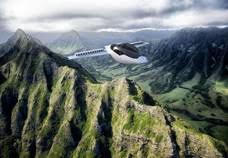
Just when we thought that we had a problem with drones, now Engineering and Technology Magazine reports that a German start-up is developing a personal electric plane that can take off and land vertically in a small area without the need for complex infrastructure.
Lilium, the firm behind the concept, described the plane as combining the best from helicopters and fixed-wing aircraft, while avoiding their respective drawbacks.
It lands and takes off from almost anywhere like a helicopter, but is quieter and more manoeuvrable, eschewing the need for long runways required by current fixed-wing aircraft.
Once in the air, the plane swivels its rotors and continues flying like an airplane at speeds of up to 400km/h.
“Our goal is to develop an aircraft for use in everyday life,” explained Daniel Wiegand, CEO and one of the company’s four founders.
“We are going for a plane that can take off and land vertically and does not need the complex and expensive infrastructure of an airport. To reduce noise and pollution, we are using electric engines so it can also be used close to urban areas.”
All the plane needs to land and take off is an area measuring approximately 15 meters squared, roughly the size of a modest back garden.
When developing the concept, the designers were wary of safety problems plaguing helicopters. The aircraft therefore has an extra set of batteries, engines and controllers to provide a safety net if anything goes wrong.
To obtain a license to pilot the aircraft, the applicant would have to undergo 20 hours of training – not much more than what is needed for a regular driving license.
This is possible thanks to sophisticated computer control systems that heavily assist the pilot during the take-off and landing phases, which are generally the most difficult parts of a flight.
Classed as a light sport aircraft for two occupants, the plane is targeted for the consumer market and the team hopes to make it commercially available in about two years.
Designed for recreational flying, the plane is restricted to flying in good weather conditions and in uncongested airspace with a maximum altitude of 3km.
The Munich-based company has already tested small-scale prototypes weighing up to 25kg.
The firm, which developed the aircraft with help from the European Space Agency, described the aircraft as the first of its kind in the world.
Who knows if the concept will become reality, but in addition to its potential benefits it could propose another challenge for governmental aviation organizations as it enters the already crowded skies. Editor.
Image Source: Engineering and Technology Magazine
